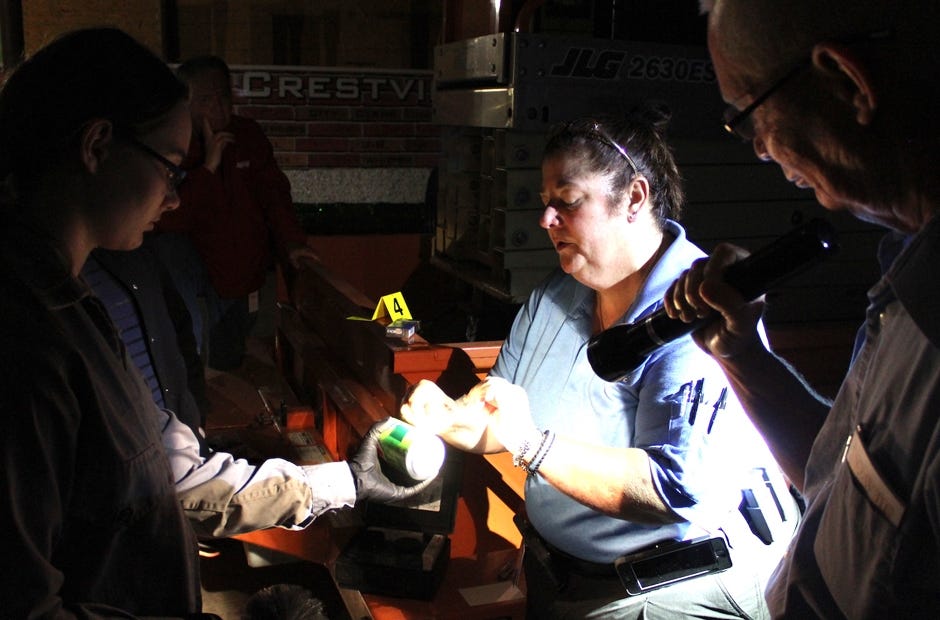![Crestview Police crime scene investigator Jennifer Bellamy demonstrates how she dusts an object for fingerprints during the April 4 Crestview Citizens Police Academy class. [Brian Hughes | Crestview Police Department]](http://127.0.0.1/wordpress/wp-content/uploads/2022/01/ghows-DA-4c4ab0ca-b976-4d56-e053-0100007fd734-c8bb96c9.jpeg)
CRESTVIEW — Crestview Police Department crime scene investigator Jennifer Bellamy surveys the site of a murder. A body lies on the floor partially beneath a scissors lift; a puddle of blood surrounds its head.
Nearby objects include a coffee cup, a soda can, a cigarette pack, several spent casings and a used tissue. Any or all of them could yield clues to solve the case.
The "crime scene," in fact, is a mock-up. The body is a mannequin, the pool of blood is produced by generous use of a red permanent marker, and the "clues" were carefully placed around the scene in the Whitehurst Municipal Building warehouse.
"What should I do first?" Bellamy asks participants in this spring's Crestview Citizens Police Academy.
With students' input, crime scene tape is strung around the site. Bellamy then shows how the scene is photographed, and, with students' assistance, places yellow number markers by each object.
Academy participants soon discover "CSI: Crestview" is much more involved than events depicted in the popular TV series.
Lifting a single fingerprint, for example, can take up to 20 minutes to ensure the evidence is found, isn't smudged, is lifted, is secured on a card, and is properly logged. A single, innocent clerical error could result in the evidence being thrown out in court if attacked by a resourceful defense attorney, Bellamy said.
Bellamy joined CPD in November 2016 as a crime scene investigator and evidence custodian. She has more than 28 years of police experience, starting with a career at the Okaloosa County Sheriff's Office.
"I did everything there was to do there," including serving as a patrol deputy, a dispatcher, a K-9 officer, evidence clerk and crime scene investigator, Bellamy said.
She said it was her high school Armed Services Vocational Aptitude Battery that led to her career field.
"They said I should go into either the military or law enforcement," she said. "I chose law enforcement."
Her peers in the Property and Evidence Association of Florida recently recognized Bellamy’s extensive CSI experience and elected her as president of the regional chapter. Chapter 9’s first meeting of the year is May 4 at the Crestview Police Department. Then, Bellamy will be formally installed.
"My job overall is helping officers and making their job easier, obtaining clues and helping solve crimes," she said. "I love it!"
Using a database of fingerprints, law enforcement agencies can match prints with people.
Here’s the process for finding and preserving fingerprints, which can be slow to assure evidence is not damaged in the process:
1. Using a black powder made primarily of volcanic ash, the crime scene investigator dabs the powder onto an object with a soft brush until prints are revealed.
2. Clear tape manufactured specifically for this purpose is applied over the print and surrounding area.
3. The investigator prepares an identity card for the print, noting the case number, date, assigning a distinctive print number, the investigator’s name, and making a rough drawing of where on the object the print was found.
4. The tape is slowly removed, "lifting" the print with it. The tape is then stuck onto the glossy side of the identity card, sealing the print safely.
5. The print is later photographed and compared to regional, state and national law enforcement databases.
How to find and preserve a fingerprint


This article originally appeared on Crestview News Bulletin: Crestview investigator to head professional association
